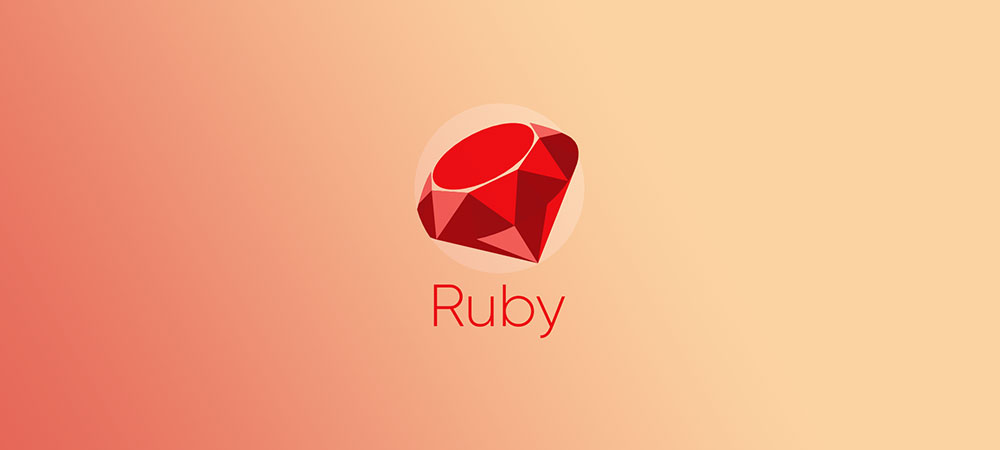18 React Alternatives That Will Revolutionize Your Workflow

Ever had that “Aha!” moment when you realize there’s more to the world than your comfy bubble? That’s the epiphany waiting to hit if you’ve only ever cozied up to React for web design. Now, don’t get me wrong – React’s great. It’s like that trusty old hammer in your toolbox. But sometimes, the job calls for a screwdriver, you know?
This write-up’s your gateway to a universe bursting with vibrant React alternatives. Ready to be amazed? You’ll discover the ins and outs of selecting the adept JavaScript accomplice, tailored just right for your web creation escapades.
By the final dot, you’ll be brimming with know-how on:
- The virtual DOM that’s not so virtual in other frameworks
- When to pick a component-based architecture without the React badge
- The front-end libraries shaking things up in the UI universe
Buckle up. It’s not just about picking a new flavor; it’s about enriching your developer’s palette.
React alternatives
| React Alternatives | Best For | Key Features | Learning Curve | Performance |
|---|---|---|---|---|
| Vue.js | Small to large-scale projects | Two-way data binding, Virtual DOM, Single File Components | Easy | High |
| Angular | Enterprise-level applications | TypeScript, Dependency Injection, CLI | Steep | High |
| Svelte | Innovative projects valuing performance | No virtual DOM, Compile-time optimisation | Moderate | Very High |
| Preact | Projects requiring a lean alternative to React | Lightweight, React-like API | Easy | High |
| Ember.js | Ambitious web applications needing a full-featured framework | Convention over configuration, Strong routing | Moderate | High |
| Aurelia | Apps that need clean, standards-based code | Clean MV* architecture, Extensible | Moderate | High |
| Elm | Functional programming enthusiasts | No runtime exceptions, Immutable architecture | Steep | High |
| Mithril | Single Page Applications (SPAs) | Minimalist, Auto-redrawing, Routing out-of-the-box | Moderate | High |
| Riot.js | UI-focused apps with custom tags | Custom tags, Minimalistic, Reactive functions | Easy | High |
| Stencil | Web component authors | Lazy loading, TypeScript ready, Integrates with other frameworks | Moderate | High |
| Hyperapp | Small-scale, functional apps | Small size, State management, No virtual DOM | Easy | High |
| Inferno | High-performance, mobile-friendly apps | Fast rendering, React-like API | Moderate | Very High |
| Alpine.js | Adding interactivity with minimal footprint | Lightweight, Declarative rendering | Easy | High |
| Lit | Building fast, lightweight web components | Simple API, Reactive properties | Moderate | High |
| Backbone.js | Web applications needing minimal structure | MVC pattern, Lightweight, Rich Event API | Easy | Moderate |
| Solid | Simplicity, apps needing fine-grained reactivity | No virtual DOM, Simple state management | Moderate | High |
| Marko | Isomorphic applications (server and client rendering) | Efficient updates, Lightweight runtime | Moderate | High |
| Vanilla JS | Maximum control, browser compatibility | No overhead, Broadest support | Depends on the user’s existing knowledge | Depends on implementation |
Vue.js
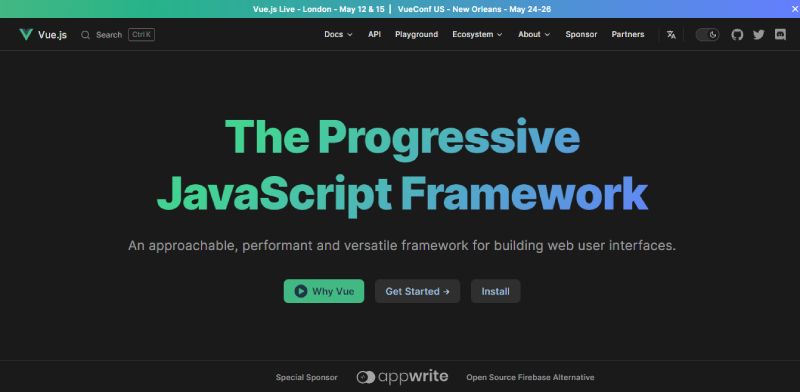
Vue.js is like that chill friend who’s super easy to get along with. It hits sweet spots with its simplicity and flexibility, making it a go-to for developers who want to create stunning interfaces without the fuss. It’s lightweight, adaptable, and integrates smoothly with other technologies.
Best Features
- Approachable and adaptable
- Detailed documentation
- Reactive and composable
- Strong community support
What we like about it:
The reactive two-way data binding is a crowd-pleaser for sure—it makes syncing user interface and data a walk in the park.
Angular
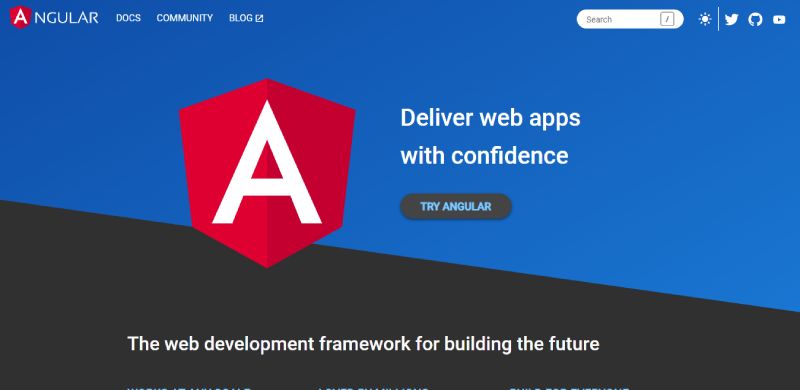
Angular is the grand architect’s toolkit. Maintained by Google, it brings order to your project with a robust framework that’s designed for crafting scalable and well-structured applications. It’s all about productivity and maintainability when your app’s ambitions are skyscraper-high.
Best Features
- Dependency injection
- TypeScript-based
- MVC architecture
- Integrated suite of tools
What we like about it:
Angular’s command over TypeScript lays down the law for more consistent and fewer error-prone apps. That’s the clincher.
Svelte
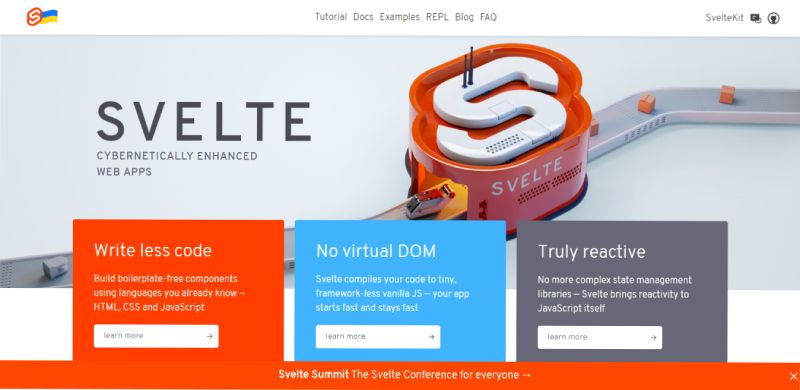
Svelte rewrites the script—literally—transforming your code during build time to optimize interactions. Bid farewell to the virtual DOM, Svelte applies updates surgically for that performance edge. It’s like magic; code that anticipates its moves, resulting in a delightful dance of efficiency.
Best Features
- No virtual DOM
- Less code
- Reactive without overhead
- Compile-time optimization
What we like about it:
It’s the next-gen compiler magic that steals hearts, crafting the ultimate zero-abstraction experience.
Preact
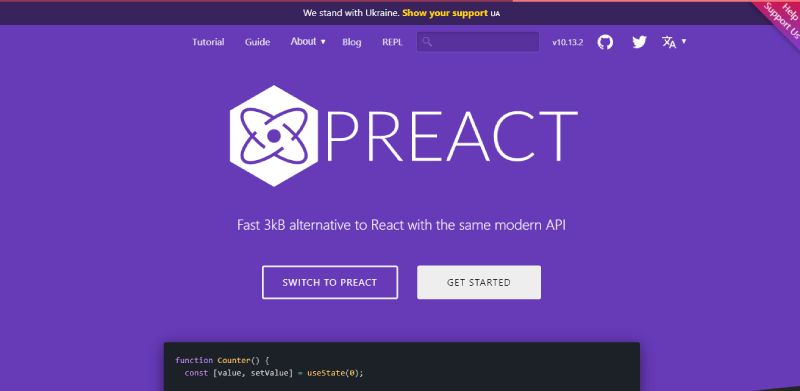
Preact plays the minimalist game like a boss, offering the goodness of React without the weight. For a project that needs to be lean and mean, you can trust Preact for all the performance perks without bulking up with unused features.
Best Features
- Lightweight footprint
- React-friendly API
- Fast performance
- Easy to migrate from React
What we like about it:
Super light framework that doesn’t compromise on speed; it’s quick on its feet and easy to dance with.
Ember.js
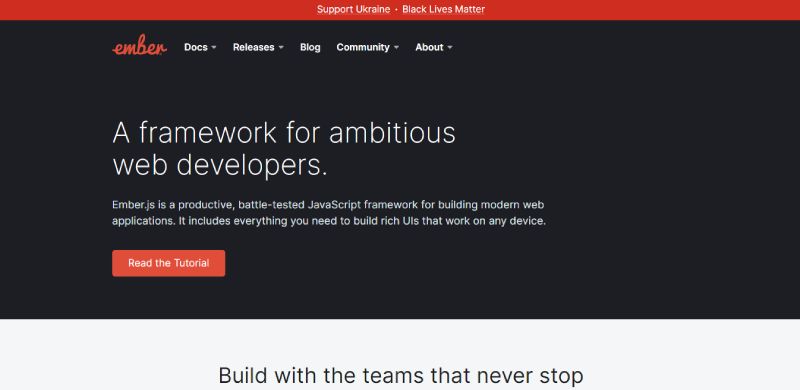
Ember.js is like the all-inclusive resort of JavaScript frameworks. It’s got everything under the sun bundled into one consistent, opinionated package. It sticks to conventions, which means less time spent on decisions, more on building actual features. Ideal for ambitious web apps that aim for the stars.
Best Features
- Built-in best practices
- Full-featured framework
- Embraces convention over configuration
- Strong routing
What we like about it:
The powerhouse routing system in Ember is top-notch, a real pathfinder for complex apps with many moving parts.
Aurelia
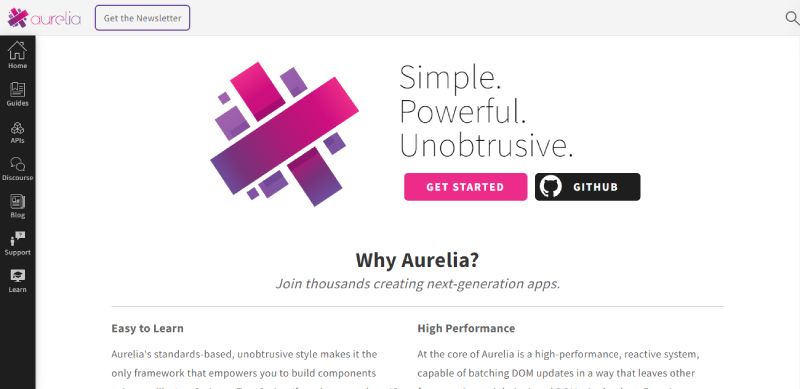
Aurelia is like that artisanal bread—it’s made with care, understanding, and with a focus on purity. It’s a forward-thinking framework that believes in clean, unobtrusive code. Aurelia is about adherence to web standards, ensuring your apps are as future-proof as they can be.
Best Features
- Clean, standards-based code
- Intuitive binding engine
- Extensible and testable
- Convention over configuration
What we like about it:
Its commitment to clean, standards-based coding practices makes it a fine choice for devs looking to keep it neat and tidy.
Elm
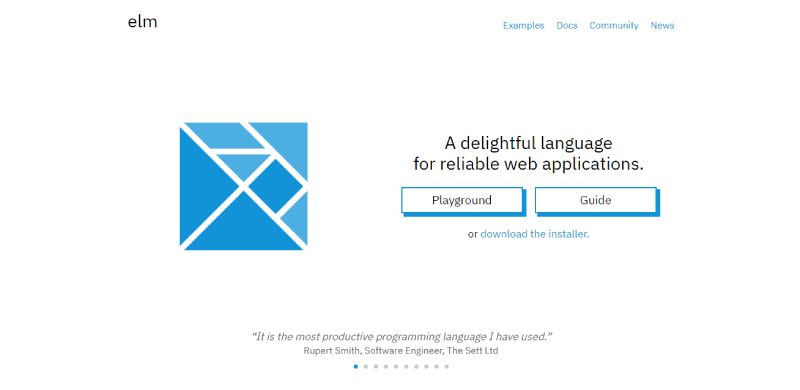
Elm is the soothing tea for the jittery nerves of JavaScript developers. With no runtime exceptions, it’s like a zen garden for web app constructions. This functional programming language compiles to JavaScript, offering a delightful developer experience, complete with its own architecture and strict types.
Best Features
- Zero runtime exceptions
- Enforce semantic versioning
- Time-travelling debugger
- Functional programming paradigm
What we like about it:
Time-travelling debugger is the pie in the sky. Jump back in time, fix the glitch, and forward you go. Pure sorcery!
Mithril

Mithril is that spry sprinter who specializes in performance. A tiny, speedy JavaScript framework, it shines for its simplicity and out-of-the-box routing capabilities. It’s perfect for single-page applications where speed is the heartbeat and bloat the arch-nemesis.
Best Features
- Minimalist and nimble
- Out-of-the-box routing
- Automatic redrawing system
- Hierarchical MVC components
What we like about it:
The ease with which you can climb aboard and hit warp speed with zero setup fuss—quick to learn, quicker to execute.
Riot.js
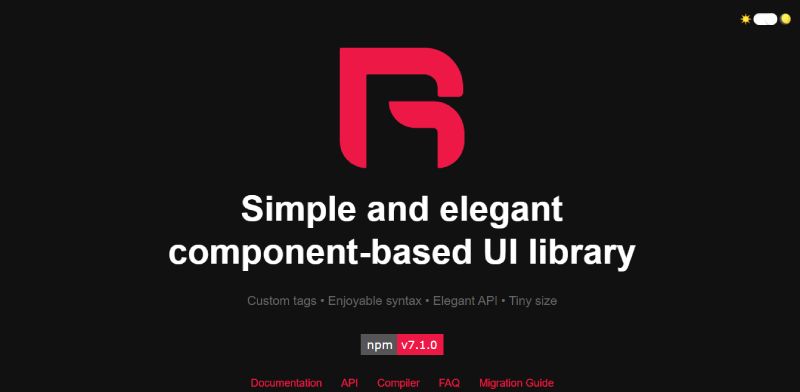
Riot.js is the punk rock of JavaScript frameworks. It defies the heavyweights with its ultra-lightweight core, offering modularity and simplicity akin to native custom elements. It leads the charge for simplicity in UI creation, with a clear focus on expressiveness and flexibility.
Best Features
- Minimalistic approach
- Custom tags
- Elegant syntax
- Reactive functions
What we like about it:
Its enticing simplicity and custom tags bring a breath of fresh air, making UI development feel almost poetic.
Stencil
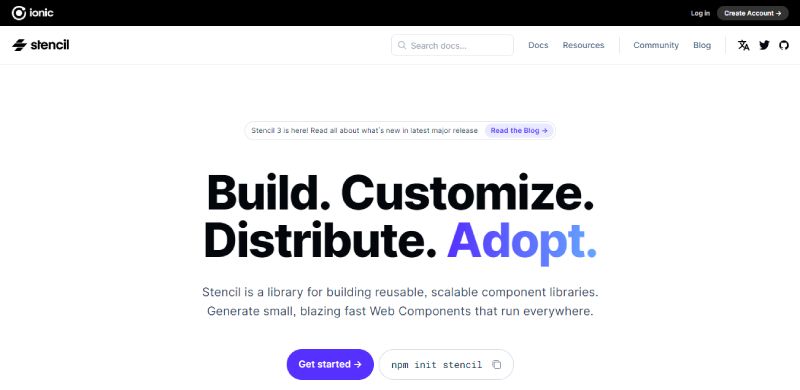
Stencil is the new stencil on the block, ready to trace out the new wave of web component development. Pushing forward the boundaries of static site generation, it’s a magic kit helping devs conjure up future-proof components that run anywhere—fast, easy, and standard-compliant.
Best Features
- Generates web components
- Lazy-loading
- TypeScript ready
- Integration-friendly
What we like about it:
Stencil’s power lies in building lightning-fast web components that can stand solo or merge with other libraries—truly versatile.
Hyperapp
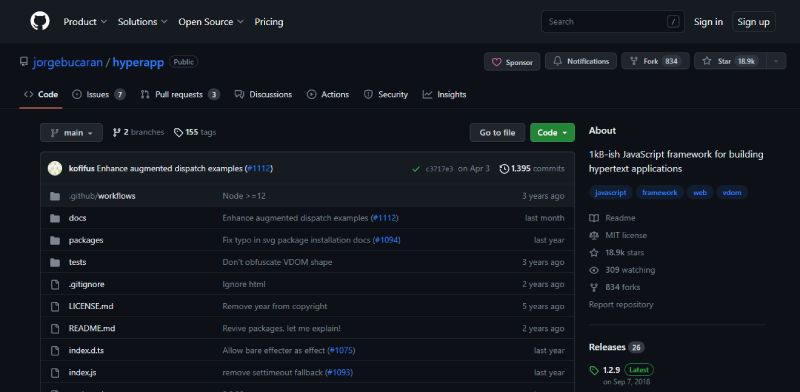
Hyperapp takes you on a featherweight escapade while still packing a powerful punch. With Hyperapp, it’s all about building web apps in a functional manner with a tiny footprint. It dodges the bloat and complexity, offering a streamlined path to web development nirvana.
Best Features
- Functional paradigm
- Small size
- State management
- Minimalistic design
What we like about it:
Being able to handle state actions and views in a neat, single-package solution—keeping it simple yet functional.
Inferno
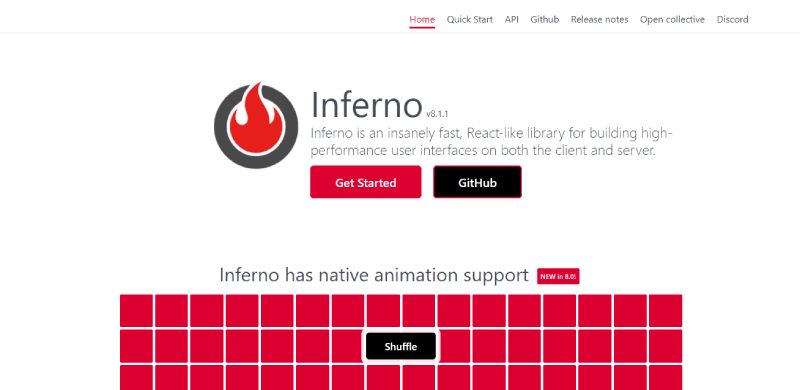
Inferno is the Usain Bolt in the realm of React-like libraries. It’s an uncompromising powerhouse focused on delivering blazing speed. If high performance is the race, Inferno crosses the finish line with its highly optimized rendering techniques, all without skimming on the developer experience.
Best Features
- Exceptionally fast rendering
- React-like API
- Component-driven
- Server-side rendering
What we like about it:
Inferno’s eye-watering speed, especially on mobile, is a clear winner. It doesn’t just run; it sprints.
Alpine.js
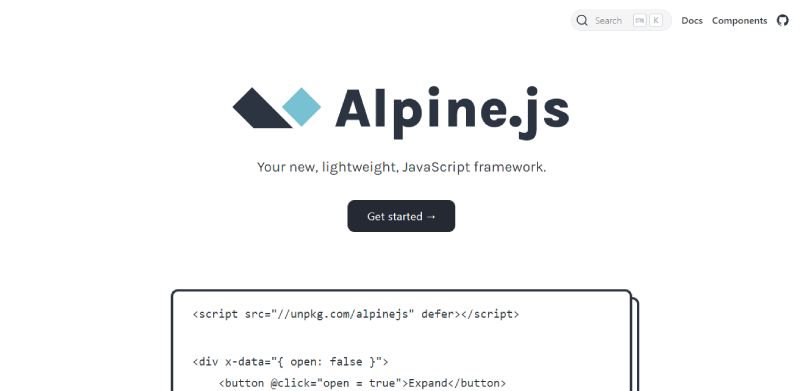
Alpine.js is like that Swiss Army knife that’s compact but always surprises you with what it can do. It’s nimble and expressive, inspired by Vue, but with none of the heavyweight baggage. Alpine prefers to keep things straightforward and sprightly for adding that interactive zest to your pages.
Best Features
- Lightweight
- Declarative rendering
- No virtual DOM
- Reactive and declarative data binding
What we like about it:
Its focus on simplicity and size makes it the go-to for sprinkling interactiveness without the bloat.
Lit
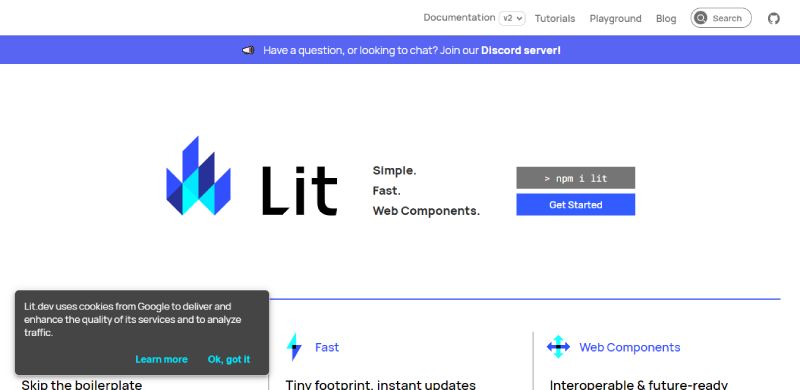
Lit, short for LitElement and lit-html, is the lightweight, shine-bright-like-a-diamond toolkit for building fast, efficient web components. It’s all about creating expressive, lightweight templates that are a breeze to maintain. It’s the artisans’ choice for crafting with web standards in mind.
Best Features
- Efficient updates
- Simple API
- Interoperable components
- Reactive properties
What we like about it:
Lit’s claim to fame is its simplicity in crafting powerful web components without the need for complex state management systems.
Backbone.js
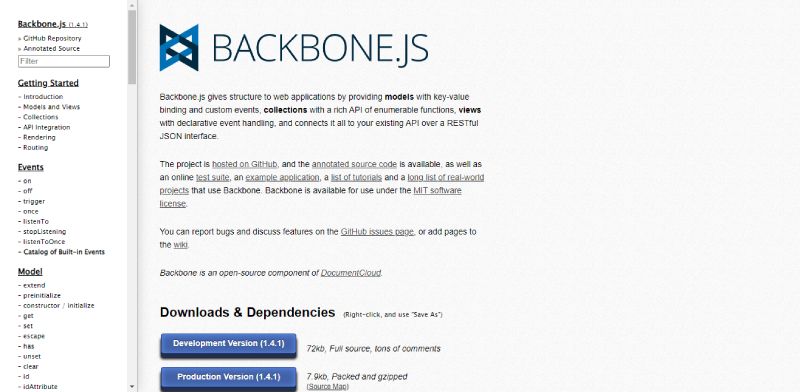
Backbone.js stands as the seasoned sage of JavaScript frameworks. It’s minimalist yet powerful, providing the scaffolding to structure web applications by offering models, views, collections, and events. It’s about getting back to basics, giving you the freedom to architect your app, your way.
Best Features
- MVC framework
- Lightweight
- RESTful JSON interface
- Rich API of enumerable functions
What we like about it:
The unopinionated nature that leaves room for creativity and flexibility—an open canvas always ready for a masterpiece.
Solid
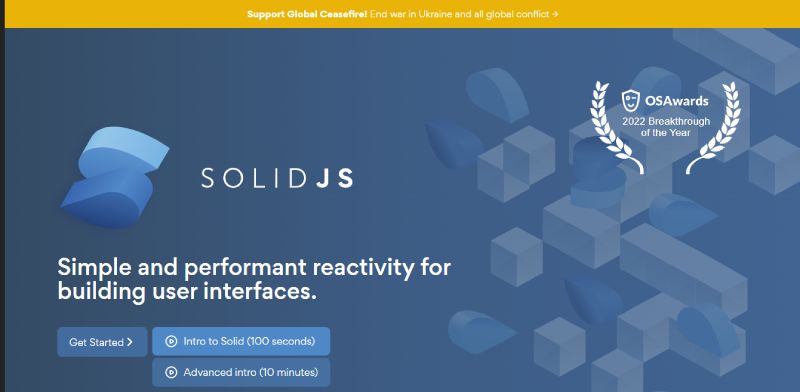
Solid is the silent guardian, opting for simplicity over sophistication. It builds on Reactive programming principles but steers away from the complexity of other libraries. Like a steady drumbeat, it provides fine-grained reactivity that ultimately leads to better performance.
Best Features
- Fine-grained reactivity
- No virtual DOM
- Templating system
- Simple state management
What we like about it:
The fine-grained reactivity strikes a chord, ensuring updates are efficient and on-point.
Marko
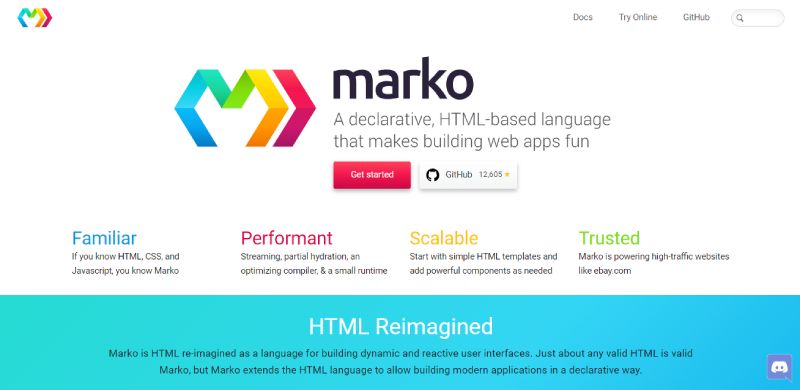
Marko is the laser-focused UI library, slicing through inefficiencies with its optimized rendering path. It’s from eBay’s forge, designed to handle UI components both on the server and directly in the browser, rocking a smooth development experience.
Best Features
- Isomorphic library (for server and client)
- Lightweight runtime
- Streamlined data-binding
- Components that compile to HTML and JavaScript
What we like about it:
Marko prides itself on an optimized page load and seamless transitions, bridging the server-client chasm like a boss.
Vanilla JS

Vanilla JS is the zen of JavaScript, untainted by frameworks or libraries. It’s pure, it’s native, and it’s powerful enough to build anything from a simple website to a dynamic web application. It offers the ultimate control and the highest compatibility across all browsers.
Best Features
- No additional overhead
- Ultimate control
- Broadest browser support
- Maximized performance
What we like about it:
What’s not to love about going straight to the source? It’s the raw power of JavaScript, in all its unvarnished glory.
FAQ on React alternatives
What’s a solid React alternative for large-scale applications?
Angular strides in, crafted by Google, for those monstrous apps that mean serious business. Think enterprise-level – with rigorous features, ready-to-roll TypeScript support, and well, a learning curve that’s not for the faint-hearted. It’s like upgrading to a power drill from a manual screwdriver.
Is Vue.js a worthy contender to replace React?
Vue.js is the new cool kid, with a charm that’s hard to ignore. It’s delightfully intuitive and merges the best bits of React’s simplicity with Angular’s twinkle. Plus, the community behind it? Super welcoming. Embrace Vue if you dig a progressive framework that scales without a hiccup.
How does Preact stand against React in terms of performance?
Preact, oh Preact, you lightweight champion. Its tiny footprint dances around React’s, and it’s fast as lightning. For projects where performance is the showstopper and every kilobyte counts, Preact shines. Bonus – it’s practically a mirror to React, minus the bloat.
Could Svelte be the dark horse among React alternatives?
Svelte’s playing the long game, forging a path as the underdog. It steps away from the norm, ditching the virtual DOM act, compiling your code to surgical JavaScript that updates the DOM when the state changes. It’s the out-of-the-box maverick best suited for developers craving a compile-time magic trick.
For mobile development, what’s a close kin to React Native?
Flutter, courting developers with its rich widgets and buttery-smooth animations, is flying high as React Native’s cousin. Dart’s the language it speaks, a tongue from Google’s own archives. Flutter’s ace? It doubles down on performance and that seamless native feel for both iOS and Android.
What are the key advantages of using Ember.js instead of React?
Ember.js is for those who value convention over configuration. This framework escorts you with strong opinions, which means less bike-shedding and more building. It’s an all-in-one framework, so you’re over the whole “plugin hunting” ordeal. Plus, its consistency in design patterns is nothing short of impressive.
Angular or Vue.js – which is better for a React developer to learn next?
Dive into Vue.js if React’s your starting point. The leap won’t make you sweat; it’s got a soothing familiarity with a comfortable learning curve. Angular? Ah, that’s when you’re game for a challenge, ready to tackle TypeScript and have a penchant for the architectural robustness. Choose your own adventure.
Can Backbone.js still compete with React today?
Backbone.js has its charm with the nostalgia of simpler days. It’s like that reliable old hatchback. Yet, in the fast lane where React cruises, Backbone’s simpler structure seems modest. For those lean, lightweight projects, or when you yearn for straightforward, “back to basics” coding, it might just click.
Does using a React alternative affect the potential recruitment of developers?
Sure thing, it does sway the dev crowds. While React gathers a posse of ready-to-roll developers, straying off the beaten path might require a tad more effort to rally troops. Yet, for a framework like Vue or Angular, worry not – their battalions are vast and eager to code.
When you’re in need of top-notch Reactjs development services, sticking with React makes perfect sense. It’s a stellar pick, especially when you’re looking to leverage a sea of resources, a booming community, and an already React-fluent team. Sometimes, the original is just the ticket.
In what scenarios is it better to stick with React instead of looking for alternatives?
When you’re deep in the Facebook ecosystem or the virtual DOM is your playground, clinging to React makes perfect sense. It’s a stellar pick, especially when you’re looking to leverage a sea of resources, a booming community, and an already React-fluent team. Sometimes, the original is just the ticket.
Ending thoughts
So, the journey’s been quite the ride, right? Look, exploring React alternatives isn’t about ditching the familiar—it’s about opening doors to fresh possibilities.
We dove into the waters of Vue.js, with its intuitive vibe, and scaled the heights of Angular‘s enterprise kingdom. Got our hands dirty with the nifty footwork of Preact, and even caught a glimpse of Svelte, the maverick changing the game.
- Vue.js: It’s friendly, it’s progressive, it grows with you.
- Angular: It’s got the muscle for the big, complex stuff.
- Preact: Packs a punch in performance, keeps things small.
- Svelte: The rebel, cutting out the middleman for smoother moves.
Wrapping this up, remember, it’s not just about the tools; it’s what you build with them. So go ahead, pick the one that resonates with your groove and start creating something awesome.
If you liked this article about React alternatives, you should check out this article about Hadoop alternatives.
There are also similar articles discussing Next.js alternatives, Bootstrap alternatives, Java alternatives, and JavaScript alternatives.
And let’s not forget about articles on GraphQL alternatives, jQuery alternatives, Django alternatives, and Python alternatives.
- Why a UX audit is essential for your business and how it can improve customer satisfaction - May 3, 2024
- Free Photo Editing: Apps Like GIMP - May 2, 2024
- How UX/UI Design Creates Winning Web Apps - May 2, 2024






